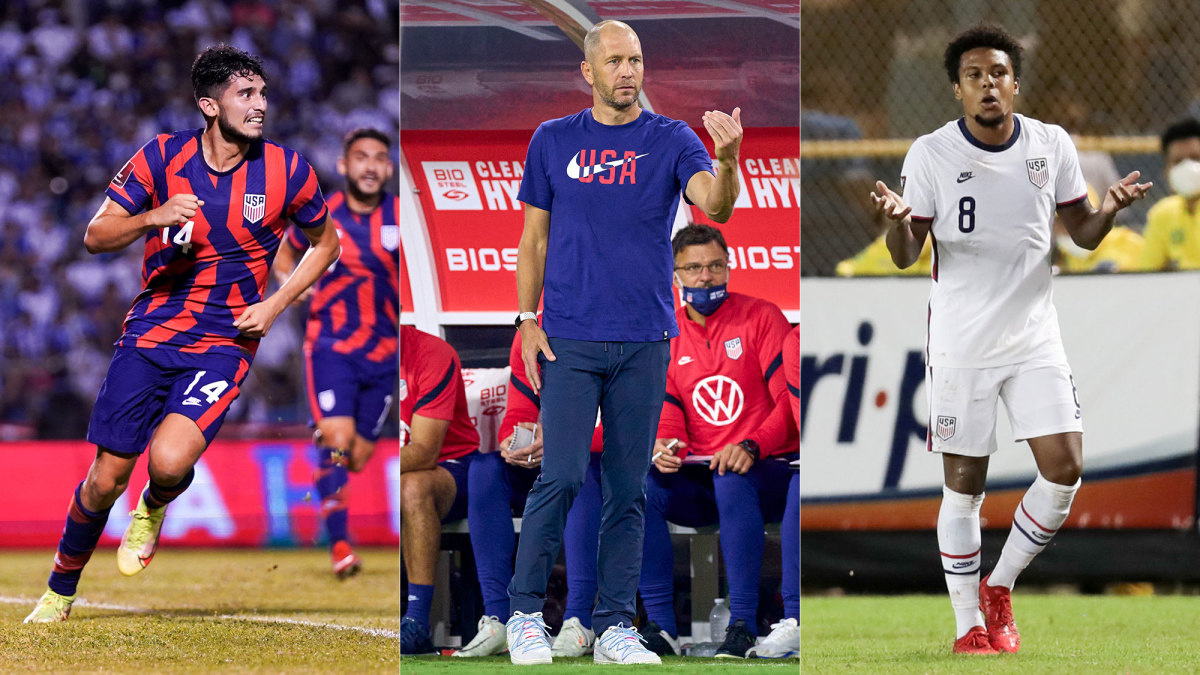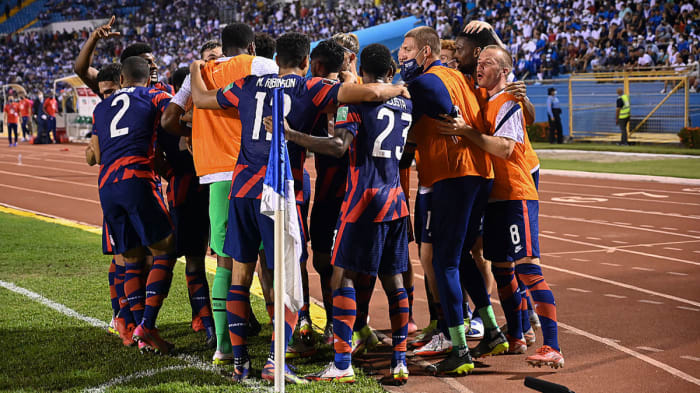
Finding Perspective After USMNT’s Mixed-Result First World Cup Qualifying Window
Perspective is a useful tool, especially in an age of knee-jerk reactions and sizzling-hot takes. The U.S. men’s national team, three games into its 14-match World Cup qualifying campaign, is, all things considered, in fine position to achieve its ultimate goal. Five points from three matches—including two away from home—is an acceptable tally, albeit not wholly satisfactory. Considering the injuries, self-inflicted absences and other factors, five points actually seems about right in hindsight. The U.S. didn’t play particularly well on the whole, with circumstances including but not limited to tactics and individual player performance all part of the puzzle.
Now that the first three-game-in-seven-days window is complete, it’s possible to look back with some of the perspective that’s not necessarily available or applicable in the moment to review the entirety of what just transpired. Depending on your glass-half-full or glass-half-empty worldview, there’s a lane for you to pick. One on hand, the U.S. just played three of the four lowest-ranked sides in the Concacaf Octagonal and could muster only one win while also slipping to a home draw vs. Canada. That's not very encouraging. On the flip side, it has already taken more points (four) from away matches in this final round of qualifying than it did in all of the futile qualifying effort for the 2018 World Cup (three). That's a nice bonus, especially considering the lack of Concacaf road experience among the squad. Despite the reasonable levels of panic setting in after Honduras took the lead Wednesday night, the U.S. has trailed for just 21 minutes and, as Gregg Berhalter pointed out already, has yet to lose. Tyler Adams, Miles Robinson, Brenden Aaronson and Matt Turner proved their bona fides, while Ricardo Pepi emerged as a potential star.
The manager’s propensity to sometimes downplay poor results or take a more analytic and measured approach to them may not sit well with supporters who demand instant greatness or immediate consequences, but it's probably a more true and accurate reflection of the state of the union. It’s that perspective thing again.
That’s not to say there isn’t cause for concern after three matches. Clearly, not everything went according to plan, but such is often life in the Concacaf cauldron. With the next international window not opening for another few weeks, here’s a closer look at what are and perhaps are not dire issues for the U.S. on the winding road to Qatar 2022:
PERHAPS OVERBLOWN
U.S.’s qualifying position
Through three matches, the U.S. is one of three nations (Canada, Panama) that trails first-place Mexico by two points. The U.S. sits in third after the tiebreakers, but table positioning this early in the Octagonal is hardly set in stone. As Berhalter pointed out after Wednesday night’s win, even a defeat would not have condemned the U.S. to failure. It surely would have made the job that much more difficult and contributed to a deteriorating morale that could have snowballed quickly, but from a purely mathematical standpoint, there’s plenty of games to be played, and it’ll be a while before anyone is clinching a berth or eliminated from contention.
It’s become quite clear that every match is going to have a must-win feel to it until there’s some separation in the standings. When the margin for error is not so great, those tend to be the stakes. Lose or draw vs. Jamaica at home Oct. 7, and then suddenly the Panama away game becomes that much more important, and so on. The only way to build up that margin for error is by taking care of business, which is more easily achievable at home. With two home games in the October window against two winless sides, taking six points from them should be the baseline requirement. That alone would let some relief seep in and let the sense of impending doom dissipate.
Berhalter’s job security
We might never know how a defeat in Honduras would have altered the calculus for the U.S. from a personnel standpoint. Had the second half on Wednesday looked like the first half and no admission of a poor match plan—admission via tactical changes, not via postgame remarks, for what it’s worth—been made, might that have been it? Would two points through three games, on the heels of all the baggage supplied by his predecessors, been enough to pull the plug on the Berhalter era?
His calm and unbothered comments before and after the Honduras win suggested that he never felt like his job was threatened, and after the summer the U.S. had and the strides it’s taken over the last couple of years, perhaps that would have been a rash call. At some point, U.S. Soccer sporting director Earnie Stewart and USMNT general manager Brian McBride may have had to assess the cost-benefit of qualifying position and changing coaches, but is one window in a 14-game gauntlet the time? Should a manager’s security be boiled down to three matches that aren’t definitive one way or another? Regardless, the win settled any uncertainty that may have arisen and simplifying things to the point that Berhalter did in the second half—familiar formation, players in positions to which they’re accustomed—Wednesday would go a long way toward ensuring that the job question doesn’t come up again.
The forward question
Barring an injury or COVID-19-related absence, it’s hard to envision anyone but Pepi starting at forward vs. Jamaica in his home state of Texas when qualifying resumes. The 18-year-old’s contribution—on his senior national team debut, no less—was so immense, and, considering the lack of statements made by Josh Sargent and Jordan Pefok when given the chance to start at striker, it appears to be Pepi’s spot to lose. He did a little bit of everything in Honduras, dropping deep to see the ball, holding it up and laying it off and making the smart runs in behind to the point that he, in some facet, had a hand in all four U.S. goals in the second half. It did Sargent a disservice Wednesday to play him on the wing, but if he’s to get on the field in his more customary central position, it figures to be as a reserve. It’s also worth monitoring the health and fitness of other forwards who didn’t wind up playing this time, such as Tim Weah, Gyasi Zardes, Matthew Hoppe and Daryl Dike. There could be a greater competition for minutes, but Pepi certainly stated his case for more of them.
GENUINE CAUSE FOR CONCERN
Weston McKennie’s status
Berhalter made an emphatic statement that no player is above the collective by omitting McKennie from Sunday's match vs. Canada and then sending him back to Juventus for breaches of team protocol that reportedly included his leaving the U.S. team bubble and welcoming an outsider into it. The door is still being left open for an October return, and we’ll know in a few weeks whether all is forgiven, but for a player of his stature on the team to commit such an infraction to the point that he was given the boot with high-stakes matches on the docket speaks volumes. Simply put, he has to know better, and the U.S. can only hope that that the consequences become motivation to fall in line and compensate by performing at a peak level. If he is left out for another window, then the likes of Yunus Musah and Julian Green, two very capable midfielders who were not part of this first go-around, could be called into some immediate action.
The injury issue
Christian Pulisic’s and Sergiño Dest’s ankles and Gio Reyna’s hamstring have little time to recover. Even if the three players are cleared to go vs. Jamaica, will they have had any match time with their clubs before that? Dortmund coach Marco Rose already indicated that Reyna will miss a few games, which is not a good sign for his fitness a month from now. There’s no word yet on the prognosis for both Pulisic and Dest. Squad rotation and depth were always going to be factors in such a compressed qualification process, but to deal with injuries to key players so early is a rough set of circumstances.
It remains wild that Adams, Pulisic and McKennie have played just 114 minutes together on the senior national team and that Adams, Pulisic, McKennie and Reyna have yet to share the field together. As Adams said so eloquently, as he often does, last week, “If we don’t go out there and do the things we’re good at, then we’re just a group of names on a piece of paper.” As in, no matter the individual talent and the club résumés that some players can boast, it doesn’t matter if they can’t all put it together as one. The first step to doing that is simply being able to take the field as one, but that’s proved to be more difficult than expected to achieve, and it may not be done until November at the earliest.
John Brooks’s form
What was supposed to be the constant on the U.S. back line suddenly looks like more of a question mark than could have been anticipated. The U.S. gave up two goals, and both were scored by the players Brooks was supposed to have marked. He lost track of Cyle Larin in the U.S. box for Canada’s equalizer in Nashville and was turned around in midfield and too slow to react to prevent Brayan Moya from having a clear look at his diving header Wednesday night in Honduras. Brooks’s struggles in Central America aren’t entirely new, but for a team with such little experience, the player who has scored in a World Cup (2014), competed (and starred) in Copa América Centenario (2016) and emerged as a quality player for a quality Bundesliga club should be able to be more of a rock. He has the tools to still get there, but this was an awful window for him, and it was punctuated by his being subbed off at halftime vs. Honduras.
Brooks is also one of five players who picked up a yellow card across the first window (an accumulation of two at any point in the Octagonal results in a one-game suspension) along with McKennie, Adams, Pefok and DeAndre Yedlin. It’s hard to envision him staying clean in a physical region like Concacaf the rest of the way (for what it’s worth, he saw yellow in the Nations League final vs. Mexico, but before that, his last yellow for the U.S. was in a 2016 World Cup qualifying match, also vs. Mexico), meaning Miles Robinson, Mark McKenzie and the rest of the U.S. center backs should be on notice that their number will need to be called. What once seemed like one of the few givens on this team may no longer be the case.
More Soccer Coverage:






